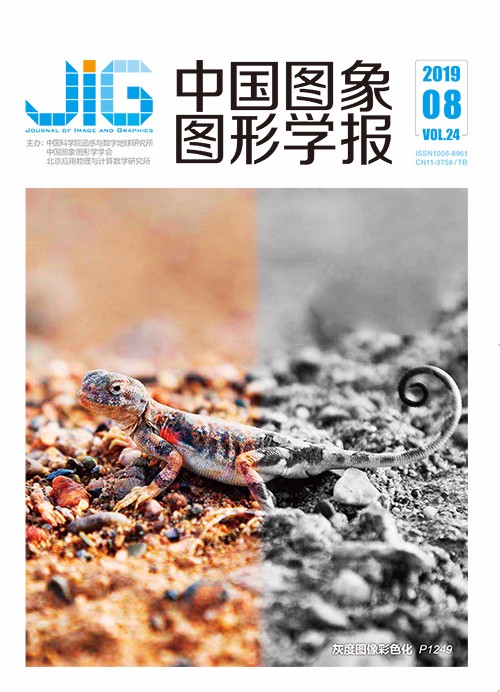
高置信度互补学习的实时目标跟踪
摘 要
目的 判别式目标跟踪算法在解决模型漂移问题时通常都是在预测结果的基础上构建更可靠的样本或采用更健壮的分类器,从而忽略了高效简洁的置信度判别环节。为此,提出高置信度互补学习的实时目标跟踪算法(HCCL-Staple)。方法 将置信度评估问题转化为子模型下独立进行的置信度计算与互补判别,对相关滤波模型计算输出的平均峰值相关能量(APCE),结合最大响应值进行可靠性判定,当二者均以一定比例大于历史均值时,判定为可靠并进行更新,将颜色概率模型的输出通过阈值处理转化为二值图像,并基于二值图像形态学提取像素级连通分量属性(PCCP),综合考虑连通分量数量、最大连通分量面积及矩形度进行可靠性判别,当置信度参数多数呈高置信度形态时,判定为可靠,进行更新;否则,判定为不可靠,降低该模型的融合权重并停止更新。结果 在数据集OTB-2015上的实验结果表明,HCCL-Staple算法与原算法相比,距离精度提高了3.2%,成功率提高了2.7%,跟踪速度为32.849帧/s,在颜色特征适应性较弱的场景和目标被遮挡的复杂场景中均能有效防止模型漂移,与当前各类主流的跟踪算法相比具有较好的跟踪效果。结论 两种子模型的置信度判别方法均能针对可能产生低置信度结果的敏感场景进行有效估计,且对输出形式相同的其他模型在置信度判别上具有一定的适用性。互补使用上述判别策略的HCCL-Staple算法能够有效防止模型漂移,保持高速的同时显著提升跟踪精度。
关键词
Real-time object tracking based on high-confidence complementary learning
Guo Wei, Xing Yuzhe, Qu Haicheng(College of Software, Liaoning Technical University, Huludao 125105, China) Abstract
Objective Object tracking is an important research subject in the computer vision area. It has a wide range of applications in surveillance and human-computer interaction. Recently, trackers based on the correlation filter have shown excellent performance because of their great robustness and high efficiency. According to correlation filter theory, an increasing number of trackers improve performance through feature fusion, such as introducing color features to strengthen the trackers' recognition ability. However, color features in some scenes with the problems of similar color objects or background clutter existing are not robust, and they can be used to evaluate the confidence of color models. In addition, traditional methods based on the correlation filter usually update the model every frame without confidence evaluation, which can lead to model drift when the target is occluded or the trackers predict an incorrect position in the last frame. Many trackers solve the above problems by conducting more reliable samples or adopting stronger classifiers, which sacrifices tracking speed. Our work focuses on incorrect samples by applying confidence evaluation because we do not need to take note of their internal details and feature structures. However, defining a comprehensive and robust evaluation index that satisfies the requirement of high speed is difficult. Therefore, a real-time object tracking method based on high-confidence complementary learning strategy is proposed. Method Our method divides the confidence problem into computing confidence independently and complementary reliability judging in the scenes with specific attributes easily leading to unreliable learning and sensitive to confidence evaluation in the sub-model. First, the average peak-to-correlation energy (APCE) for the correlation filter model is computed in Staple, which constitutes the confidence evaluation criteria with the maximum of the model response map. The result is considered high confidence only if the two criteria of the current frame are greater than their historical average values with certain ratios. Then, the correlation filter model is updated, including the translation filter and the scale filter. Next, the output of the color probability model, called the pixel-wise color probability graph in Staple, is transformed into a binary image by using the classic threshold processing method Otus, and the connected components are extracted from the binary image open operation in advance. We regard the connected component that contains the most pixels as the main connected component of the binary image. With an overall consideration of the PCCP properties, including the area of the main connected component, the amount of all connected components, and the rectangularity about the main connected component, the result is considered high-confidence. The color probability model is then updated when most of the property values take on the forms that stand for high confidence. Otherwise, the result is considered low confidence. Thus, the fusion weight is reduced, and updates to the model are terminated. Result As shown in the experiment results for the dataset OTB-2015, the distance precision of the HCCL(High confidence complementary learning)-Staple adopted high-confidence complementary learning strategy increased by 3.2%, and the success rate increased by 2.7% in comparison with the primary algorithm Staple. These improvements were achieved at a high speed of 32.849 frames per second. In the particular scenes where color features are weak to some attributes such as poor illumination condition, similar objects, background clutter, and in complex scenes where occlusion or out-of-view occurs frequently, HCCL-Staple can avoid the problem of model drift efficiently. Moreover, HCCL-Staple outperforms sophisticated trackers according to the OTB benchmark. Conclusion HCCL-Staple, which adopts the high-confidence complementary learning strategy, is an efficient scheme for addressing the problem of model drift under the traditional learning strategy in challenging scenes with occlusion and interference of similar objects. The method is enhanced by translating the tracker's learning need for reliable samples to reduce or suppress correct samples. The experimental data show that confidence computing methods and the condition for high-confidence judging work well in the correlation filter model and the color probability model and have good applicability for confidence evaluations whose model outputs the same-form result. HCCL-Staple pays less attention to feature details of the target appearance under illumination change, scale change, or deformation and focuses on confidence evaluation. Thus, HCCL-Staple achieves the same tracking effect as tracking algorithms that use complex deep features or machine learning methods and outperforms some state-of-the-art tracking algorithms even without using any sophisticated formulas and optimistic models.
Keywords
|



 中国图象图形学报 │ 京ICP备05080539号-4 │ 本系统由
中国图象图形学报 │ 京ICP备05080539号-4 │ 本系统由